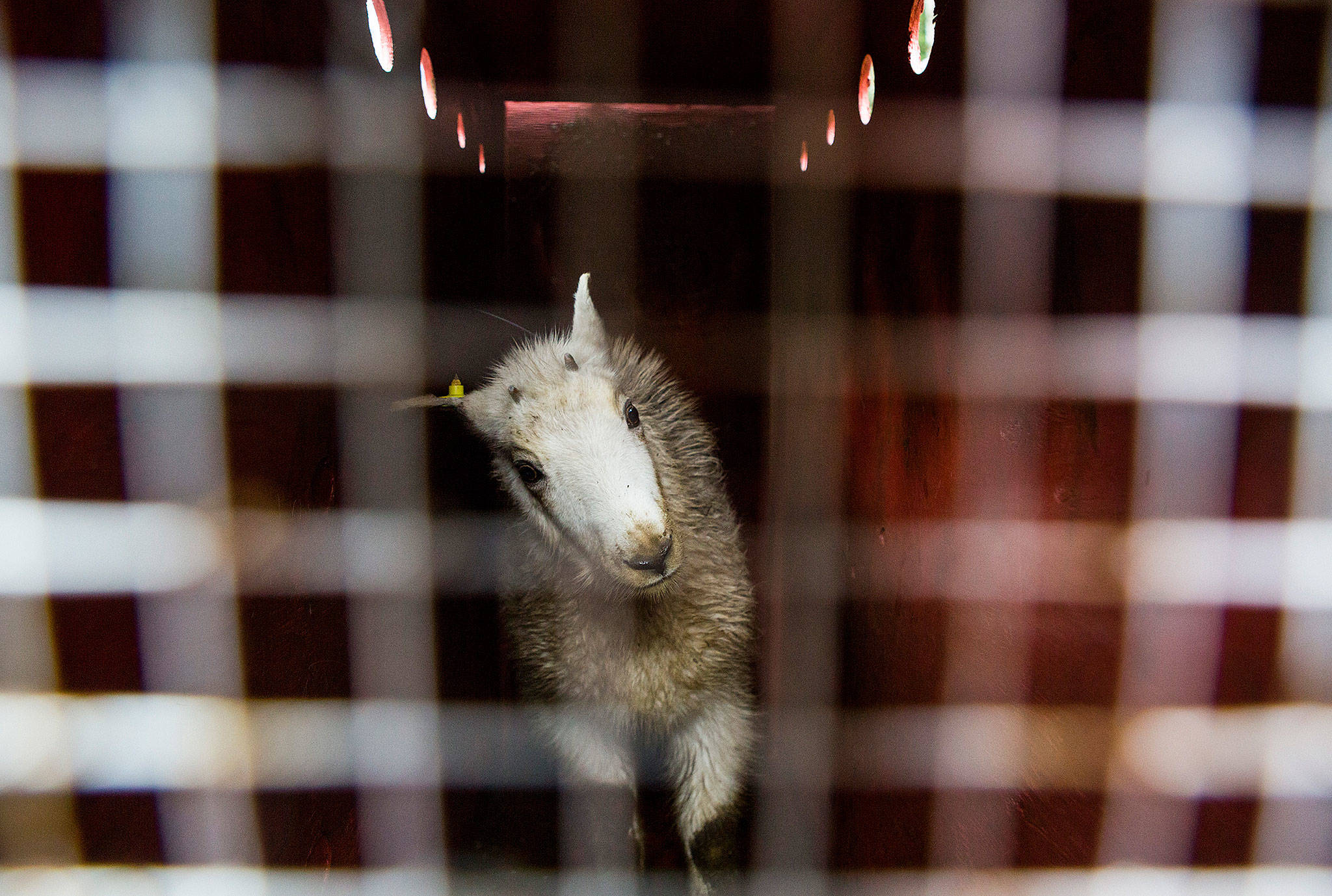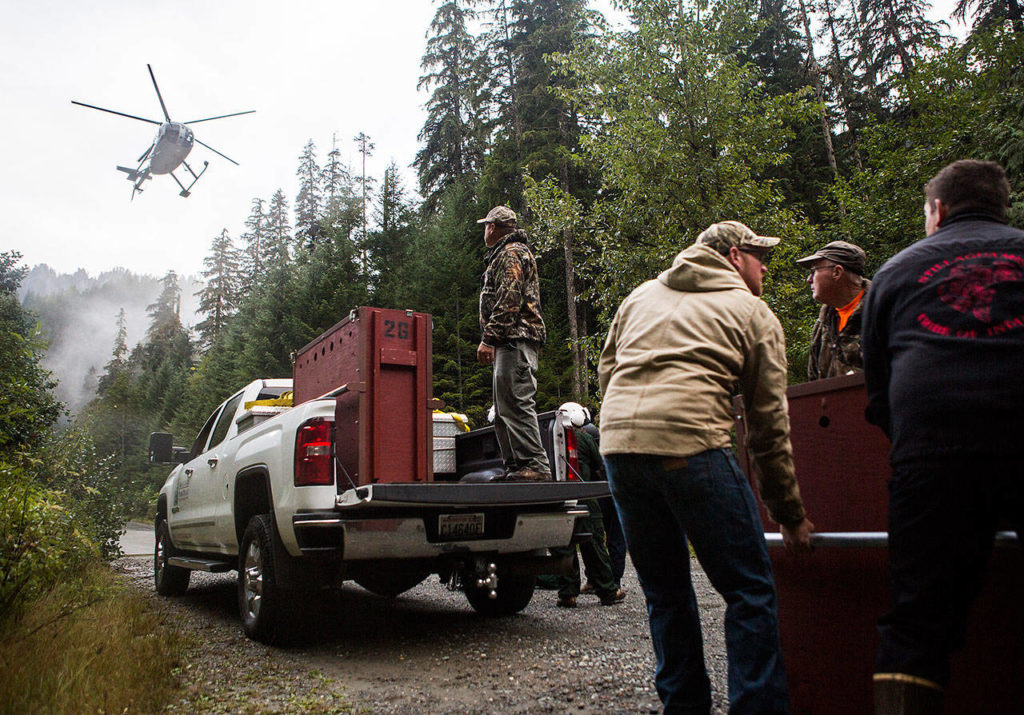MONTE CRISTO — The men were kept awake as the baby goat kicked and scratched at its crate.
They had already worked nearly 20 hours, and were looking forward to sleep.
Ron Steinman and Dayne Turgeon started their shift at 6 a.m. on Tuesday in the Olympic National Park, near Port Angeles. After helping load wild goats into trucks for 12 hours, they were on the road.
They reached their destination around midnight, parking near a gate at the Monte Cristo trailhead on the Mountain Loop Highway. They tried getting some rest in the front seats. The mountain goat and her kid were in the truck bed.
The men woke up around 5 a.m. Wednesday and started to get the animals ready for their next journey.
“You can survive on four hours of sleep, you don’t thrive on it,” Steinman said.
The pair were helping with an effort that began last week to relocate the goats. Crews hope to pluck them all from the Olympic National Forest on the Olympic Peninsula, and move them to the Mount Baker-Snoqualmie National Forest and areas nearby. It could take a few years. The plan is to transport the animals during four weeks each summer.
Steinman and Turgeon are from Edmonds, and have been friends for more than 20 years. They decided to volunteer through the state’s Master Hunter program.
While they were in the Olympic National Park, the pair watched as blindfolded goats in orange slings were lowered from helicopters into truck beds, three at a time. The animals had been caught earlier with tranquilizer darts and net guns.
Next, the goats were taken to a veterinarian, who made sure they were healthy enough for the trip.
“They were treating these goats like they would their own babies, or maybe better,” Steinman said.
After the exams, each of the critters was placed into a crate while it was still drowsy. They were mostly confined, except for holes lining the top of the box. There were two sets of moms and babies, who were able to see and smell each other through wire screens.
Volunteers lifted nine of the crates into a refrigerated truck, and the last two went into Steinman and Turgeon’s pickup.
The men spent six hours slowly driving to the Mountain Loop. They took 10 minute breaks every hour, and were careful to stop gently, so they didn’t startle the animals.
After their four-hour nap, Steinman and Turgeon waited as officials took over. They stuck around the rest of the day to make sure the animals made it to their new home.
Partners on the project include tribes, the National Park Service, the U.S. Forest Service and the state Department of Fish & Wildlife.
Darrington District Ranger Peter Forbes expected the helicopter pilot to land on a service road leading to Monte Cristo. He’s worked for 12 years in the district that makes up about a third of the Mount Baker-Snoqualmie National Forest.
Forbes provided two options, but the pilot didn’t like either. Instead, he asked to land on a nearby bridge.
“On the Mountain Loop Highway?” Forbes asked. “Has to be a first.”
The red wooden crates with the mountain goats inside were carried into the middle of the road.
The helicopter hovered as someone on the ground clipped the boxes into place using sturdy cables. The chopper lifted, and the animals were on their way to the ridges of the Cascade Range.
The crates were flown into areas near Vesper Peak and Stillaguamish Peak. The two mountains are on opposite sides of the highway, and there are more than five miles between the summits. Stillaguamish is about 4,000 feet tall, and Vesper towers 2,000 feet higher than that.
Teams released the goats as quickly as possible, to reduce the stress on the animals, said Rich Harris, a wildlife manager and goat specialist for Fish & Wildlife.
Once they were in place, the goats were let go all at once. That way, “they have a sense of, ‘Oh, I’m not alone here,’” Harris said.
Within minutes, the handlers lost sight of the animals’ white coats.
Mountain goats are native to the Cascade Range, but few remain there. It might take decades, but Harris hopes they flourish here again.
“I don’t think we have a numeric target,” he said. “Success would be breeding and slowly growing the population.”
The project has been underway since 2014, and the final version was drafted in May.
Back in 1920s, about a dozen goats from Canada and Alaska were brought to the Olympic National Forest as part of a hunting program, said Jesse Plumage, a wildlife biologist for the U.S. Forest Service.
Now, there are almost 700 near Olympic National Park. About half are expected to move here, where they’ll be tracked by radio collars. The others most likely will be in areas too remote to notice, or too dangerous to reach. Those will be shot and killed.
Because the animals aren’t meant to be in the Olympics, they’ve been harming the plants there, which don’t always grow back after the goats eat and stomp on them.
Some goats also have become used to people, and aren’t afraid to get close. In 2010, a man was killed by a mountain goat while hiking on a popular trail in the Olympic National Park.
Those known to approach humans will be placed in more isolated places.
“We’re trying to put them in areas where they can spread out,” Plumage said.
The goats are attracted to salt in human sweat and urine. There’s more salt in the environment of the Cascades to distract them.
On Wednesday, six goats were taken by helicopter. After about an hour, the fog and clouds became too heavy for the pilot to navigate. The last five were driven in by truck.
The team started to wrap up around 10 a.m. Wednesday. Steinman, Turgeon and the other volunteers were prepared to drive the goats farther into the wilderness.
Everyone started heading back to their cars as the rain began to fall harder than before. The noise from the helicopter had faded. By then, the goats were long gone.
Stephanie Davey: 425-339-3192; sdavey@heraldnet.com; Twitter: @stephrdavey.
Talk to us
> Give us your news tips.
> Send us a letter to the editor.
> More Herald contact information.



























